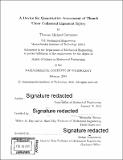A device for quantitative assessment of thumb Ulnar Collateral Ligament injury
Author(s)
Cervantes, Thomas Michael
DownloadFull printable version (15.30Mb)
Other Contributors
Massachusetts Institute of Technology. Department of Mechanical Engineering.
Advisor
Alexander Slocum.
Terms of use
Metadata
Show full item recordAbstract
Injury to the Ulnar Collateral Ligament (UCL) of the thumb, known as "Skier's Thumb," is treated by surgical repair for complete tears, or by splinting for partial tears. Because of this radical difference in treatment options, diagnostic accuracy is critical. The primary mechanism of diagnosis is through a clinical assessment of joint integrity. This method requires a high degree of examiner skill and experience, and is inherently qualitative. Secondary diagnosis through magnetic resonance imaging (MRI) is often required to ensure accurate diagnosis. This additional testing delays the treatment and adds to the cost of care. A method to quantitatively assess the thumb UCL in a clinical setting is desired. This thesis presents the deterministic design of a device to quantitatively measure the stiffness of the thumb UCL. A stepper motor is used to rotate the thumb, while a cantilever load cell is used to measure torque. The device is designed to be operated by the physician, and has alignment features to properly orient the motor axis of rotation. Several safety features were incorporated into the device, including a magnetic breakaway that prevents applied thumb force from exceeding 10 N. The prototype was constructed, and preliminary testing was performed on healthy human subjects. Peak thumb torque was measured at 213.5 ± 19.2 N-mm, and peak stiffness was calculated to be 4.70 ± 0.39 N-mm/degree. Potential pathways for further device testing and improvement are outlined. The Thumb UCL Device has the potential to improve the speed of injury diagnosis and reduce the need for imaging studies.
Description
Thesis: S.M., Massachusetts Institute of Technology, Department of Mechanical Engineering, 2018. Cataloged from PDF version of thesis. Includes bibliographical references (pages 103-105).
Date issued
2018Department
Massachusetts Institute of Technology. Department of Mechanical EngineeringPublisher
Massachusetts Institute of Technology
Keywords
Mechanical Engineering.